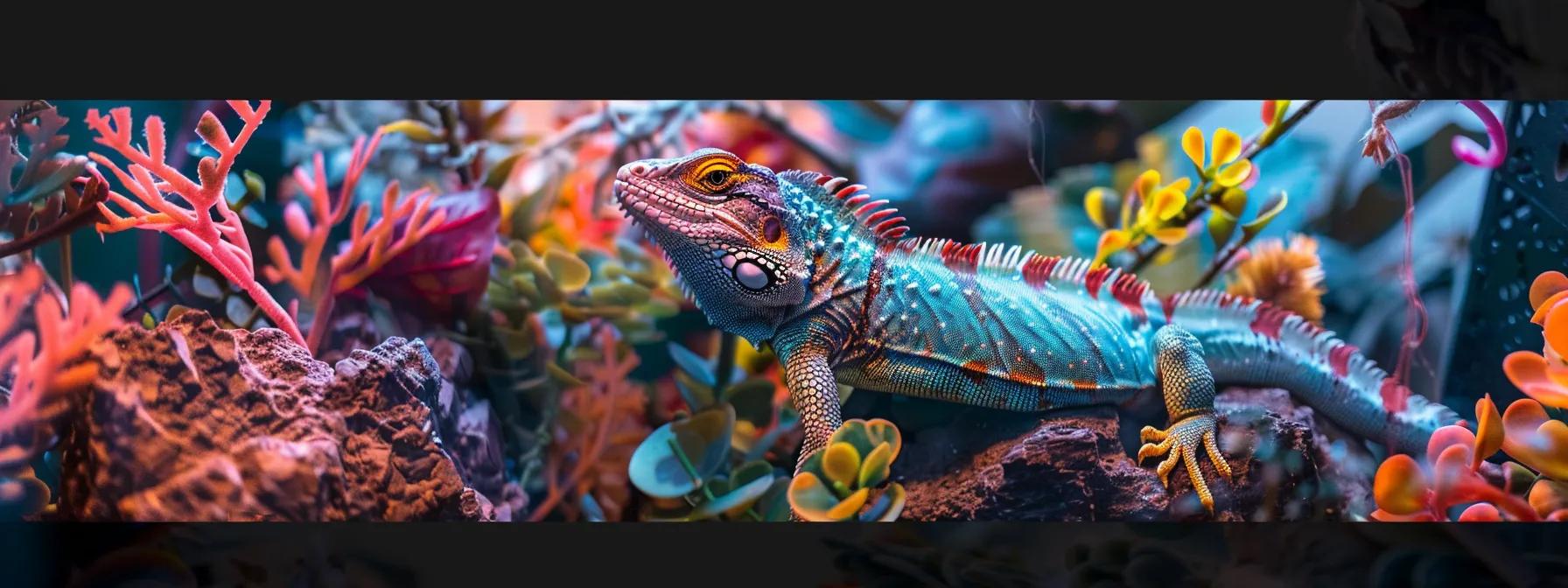
Creative Lizard Habitat Decor Ideas You Need
The design of a lizard habitat directly impacts your pet’s health by mimicking natural surroundings that promote behaviors like burrowing, climbing, and thermoregulation. This article presents a wide range of decor ideas—from choosing the right substrate to DIY projects—designed to keep your pet active, curious, and stress-free. Whether you are new to reptile keeping or an experienced enthusiast, these ideas will help create a functional yet visually stimulating enclosure that supports optimal health.
Essential Lizard Habitat Decor Ideas for a Healthy Reptile
A well-decorated habitat not only looks attractive but also supports natural behaviors and overall health. Here are key tips to create an ideal environment for your lizard.
Selecting the Right Substrate for Your Lizard's Comfort
The substrate is critical for regulating humidity, supporting burrowing, and providing a realistic look. Options such as coconut coir or reptile-safe sand simulate natural soil and allow for digging. Consider the natural habitat of your lizard when selecting the substrate, and be aware of potential ingestion issues with powdered types. Experts suggest a substrate depth of 2–3 inches for burrowing species, with a drainage layer to improve water retention and reduce mold growth. Regular cleaning and periodic replacement keep the environment sanitary, while mixing substrates can help achieve the perfect texture and moisture balance.
Incorporating Natural Branches and Climbing Structures
Branches and climbing structures add exercise, mental stimulation, and a natural feel to the enclosure. Use sturdy, pesticide-free natural or repurposed driftwood that allows your lizard to perch and bask at various heights. Arranging branches in a natural flow helps maintain temperature gradients and provides secure pathways from elevated areas to hidden spots. Some keepers also use non-toxic resin replicas for added durability. Multiple levels—created by stacking branches or adding platforms—offer diverse activity zones, reinforcing safety and a rich visual appeal.
Creating Secure Hiding Spots and Caves
Hiding spots offer sensory comfort and security by imitating crevices, caves, and rock formations found in nature. Designing caves from non-toxic resin, smooth rocks, or commercial reptile hides creates protected retreats that help regulate body temperature and reduce stress. Ensure these hideaways are sized appropriately for your lizard while remaining stable and free of sharp edges. Innovative combinations—such as integrating a small water feature or incorporating a faux log—enhance natural behaviors like thermoregulation and resting.
Adding Safe Live or Artificial Plants for Enrichment
Plants enhance the visual appeal of the vivarium and contribute to humidity regulation and oxygenation. Choose non-toxic species that thrive under similar light and moisture conditions as your pet’s natural habitat—options include pothos, snake plant, or certain carnivorous varieties. High-quality artificial plants can be an alternative, as they mimic natural textures while being easier to clean. Secure anchoring is crucial to prevent shifting during maintenance, and plants also provide additional hiding and climbing support.
Choosing Appropriate Water and Food Dishes as Decor
Water and food dishes serve practical purposes while enhancing the enclosure’s decor. A shallow water dish prevents accidental drowning while allowing a soak, and ceramic or heavy-duty glass materials are ideal because they are easy to clean and resistant to bacteria. For food dishes, choose designs that minimize spillage and substrate contamination. Some keepers incorporate feeding stations into the overall decor by embedding bowls in rock formations. Consistent cleaning and periodic replacement of these items is essential for maintaining hygiene and supporting proper digestion.
Designing Naturalistic Lizard Habitat Decor Themes
A themed habitat offers an immersive experience that reflects your pet’s natural surroundings. Whether aiming for a desert oasis or a lush rainforest, themed decor enhances both functionality and visual appeal.
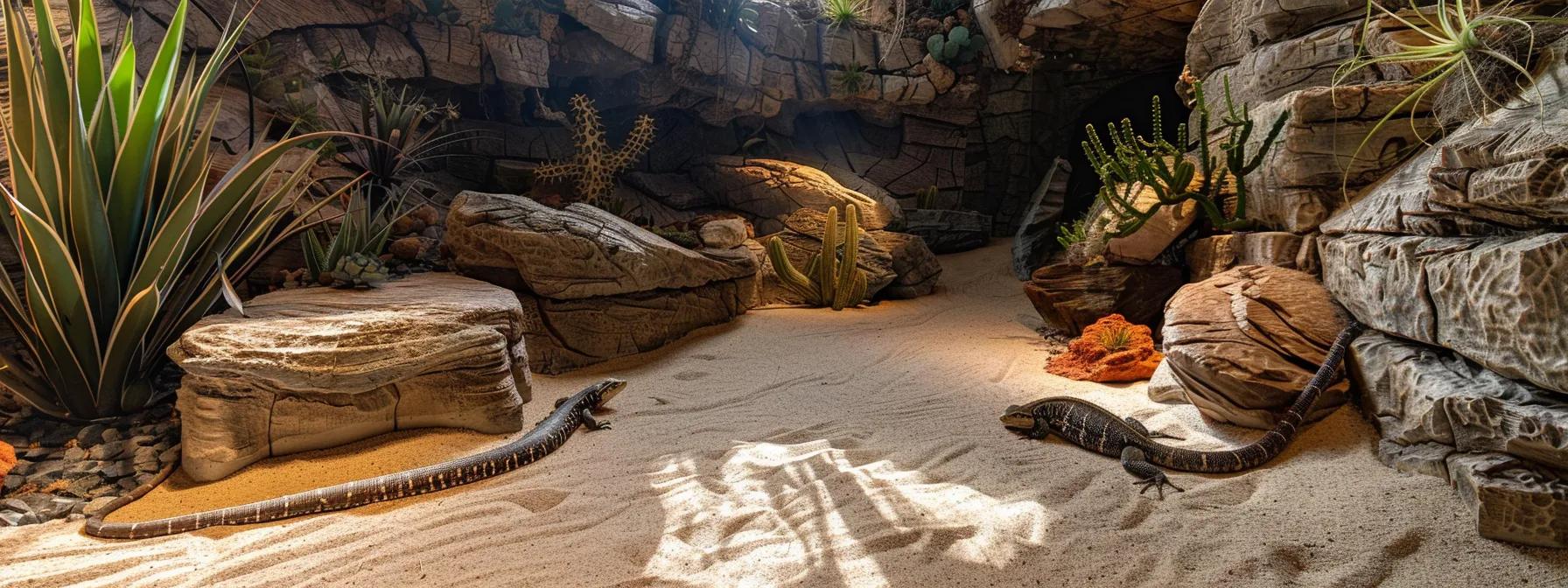
Replicating a Desert Oasis Lizard Habitat Decor Idea
A desert oasis design features sandy textures, rocky outcrops, and hardy vegetation suited for species like leopard geckos and skinks. Choose a substrate that mimics fine desert sand or crushed granite, and use flat rocks and small boulders as basking spots. Enhance the theme with artificial or drought-resistant live plants such as cacti, succulents, and desert shrubs. Driftwood or weathered logs further create the illusion of an oasis while offering climbing structures and hiding areas. This minimalistic design preserves natural basking behaviors and is easier to maintain under lower humidity conditions.
Building a Miniature Rainforest Lizard Habitat
A miniature rainforest habitat creates a lush, vibrant environment ideal for humidity-loving species like chameleons and anoles. Use a substrate mix of coco fiber, leaf litter, and orchid bark to replicate the forest floor. Key elements such as live tropical plants (ferns, bromeliads, philodendrons), strategically placed branches, and vines enrich the environment. Adding a water feature like a small cascading waterfall or misting system maintains humidity and provides soothing auditory effects. Proper lighting that mimics dappled sunlight is essential, along with temperature control to create natural heat zones.
Crafting a Woodland Lizard Habitat Decor Scheme
The woodland theme captures the soft, earthy aesthetics of a forest floor through natural mulch and soil substrates that encourage digging and foraging. Incorporate elements like natural branches, small logs, and leaves to evoke an authentic woodland feel. Live, low-maintenance plants such as mosses, small ferns, and leafy ground cover provide extra shelter and enhance the design. Irregularly shaped branches not only offer climbing opportunities but also act as natural decorative focal points. This theme supports behaviors such as burrowing and provides a cooler microenvironment that benefits many temperate species.
Developing a Rocky Outcrop Lizard Habitat Design
Ideal for arboreal and terrestrial species from rocky regions, the rocky outcrop design emphasizes natural rock formations for basking and hiding. Use a mixture of natural stones, gravel, and a thin layer of reptile-safe terrain to mimic a rugged hillside. Securely assemble rock structures with non-toxic adhesives and epoxy to create naturalistic ledges, crevices, and overhangs. This setup forms distinct microhabitats with varying temperatures, allowing your lizard to select its preferred thermal zone. Versatility in combining large boulders with smaller stones helps simulate a realistic outdoor environment.
Mimicking a Grassland Environment for Your Lizard
Grassland designs provide open, sunlit spaces with gentle undulations and scattered vegetation, ideal for terrestrial lizards that enjoy open basking while still needing cover. Select a substrate that resembles dry soil with patches of artificial or live grass, accented by green hues that evoke an expansive savannah. Functional elements such as small tufts of grass, pebbles, and minimalist logs serve as basking spots and hiding areas. Proper lighting, including UVB, is essential to support metabolic processes and overall health. Additional shelters or burrows created from non-toxic materials offer variation and privacy.
DIY Creative Lizard Habitat Decor Projects
DIY projects allow keepers to customize their lizard habitat with creative decor while ensuring safety and functionality through the use of non-toxic, durable materials.
Constructing Custom Backgrounds for Visual Appeal
Custom backgrounds transform a plain enclosure into an immersive environment. Many keepers create 3D backgrounds using foam, plaster, or polymer clay to simulate natural rock formations, tree bark, or ruins. Once molded, these backgrounds are sealed with a non-toxic, waterproof coating and can be enhanced with integrated LED lighting that mimics dappled sunlight or warm twilight. This project not only creates additional hiding and climbing spots but also serves as a central decorative piece.
Making Your Own Safe Branches and Platforms
Designing your own branches and platforms provides both functionality and a rustic charm. Using natural, untreated wood or other non-toxic materials, you can carve and sand DIY branches to resemble those found in nature. These branches can be placed strategically to form climbing pathways or resting areas. Enhancements, such as attaching faux moss or non-toxic vines, provide extra grip. Platforms built from repurposed foam or sturdy plastic—finished with textured paint—offer reliable surfaces for basking and exploration while perfectly complementing the overall decor.
Repurposing Household Items for Unique Lizard Decor
Repurposing everyday household items can create unique, cost-effective decor. Items like old ceramic dishes, plastic planters, or pieces of fabric and wood can be transformed into shelters, platforms, or decorative accents. Thorough cleaning and application of non-toxic sealants or paints ensure these items are safe for reptile use. For example, an inverted ceramic bowl can function as a water dish or hide, while an old crate may form the basis of a multi-level platform. This eco-friendly approach both personalizes and enriches your vivarium.
Crafting Edible Landscapes With Safe Plants
Integrate safe, edible plants into your habitat to create an edible landscape that combines beauty with functionality. Choose edible greens such as dandelion and select herbs or succulents that are safe for your lizard. These plants can be grown in small pots or directly in a modified substrate, and combined with non-edible decorative flora to simulate a natural ecosystem. Edible landscapes encourage foraging behaviors, allowing you to observe natural feeding habits while adding nutritional value to the habitat. Regular maintenance, including proper watering and light management, is essential.
Building a Bioactive Setup With Natural Decor Elements
A bioactive setup incorporates living components to create a self-sustaining ecosystem that reduces manual cleaning. Start with a substrate rich in organic material to support microfauna, then layer live plants to filter waste and release oxygen. Adding beneficial insects or snails aids in breaking down decaying matter. Natural decor elements like logs, rocks, and branches are integrated to provide shelter and climbing opportunities. Regular monitoring of humidity and temperature ensures the habitat remains balanced and continuously enriching for your pet.
Imaginative Themed Lizard Habitat Decor Ideas
Themed decor transforms a basic enclosure into a miniature world that reflects natural environments while stimulating your lizard’s behavior.
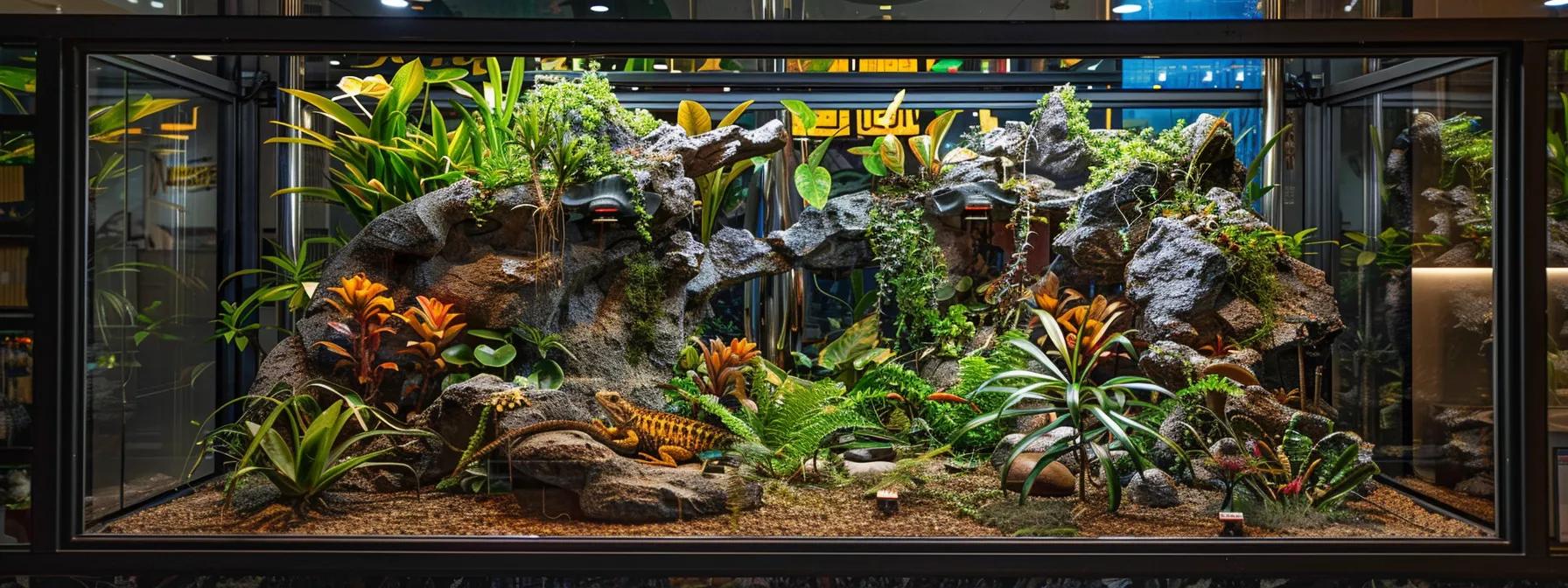
Designing an Ancient Ruins Lizard Habitat
An ancient ruins theme evokes lost civilizations with crumbling stone structures and weathered walls. Create a backdrop using plaster, foam, or textured resin that mimics moss-covered, eroded masonry. Accentuate the design with realistic details like fallen columns, arched doorways, and scattered ceramic fragments. Small plants, rusted metal accents, and ferns offer contrast by balancing decay with signs of new growth. This immersive theme provides multiple microhabitats with varied thermal zones and ample hiding spots.
Creating a Sci-Fi Inspired Reptile Enclosure
A sci-fi theme offers a modern, high-tech alternative for your lizard’s enclosure. Incorporate futuristic elements such as sleek geometric shapes, LED lighting, metallic finishes, and modular structures that create a bold, visually striking design. A modern substrate—resembling concrete or other monochromatic materials—and synthetic rock formations enhance the look, while integrated, programmable lighting adds dynamic visual effects. Maintain proper temperature and humidity with practical heating and UVB systems seamlessly incorporated into the design.
Developing a Fantasy World Lizard Habitat Decor Idea
A fantasy world theme blends whimsical elements inspired by fairytales into your enclosure. Build artificial rock formations that resemble enchanted towers or fairy tale bridges using safe molding compounds. Use small, vibrant plants like moss and miniature ferns to evoke an enchanted forest floor, while decorative elements such as faux runes, tiny statues, and sparkling water features add narrative depth. The result is a uniquely personalized habitat that stimulates natural behaviors, such as climbing and hiding, and transforms reptile care into an art form.
Assembling a Prehistoric Jungle Theme for Your Lizard
Embrace a prehistoric jungle theme with dense, untamed vegetation reminiscent of eras when dinosaurs roamed the Earth. Use a substrate comprising organic soil and leaf litter to mimic the forest floor, and accentuate it with live or artificial vines. Large, sculpted branches and faux ferns create multiple levels of activity, while strategic lighting simulates dappled sunlight through a thick canopy. Consider adding non-toxic fossil replicas or dinosaur bone accents to heighten the prehistoric feel, creating a dynamic ecosystem that encourages natural foraging and basking behaviors.
Building a Miniature Zen Garden Lizard Habitat
A miniature Zen garden creates a tranquil, minimalist environment perfect for reducing stress. Use fine sand or a soft, light-colored substrate akin to traditional Japanese gardens. Arrange smooth, flat stones as both decor and functional basking platforms, and add minimalistic live or artificial plants to inject subtle color. The design emphasizes clean lines, uncluttered spaces, and asymmetry, providing a timeless, calming ambiance that complements natural behaviors such as deliberate, slow movement and controlled basking.
Selecting Safe and Stimulating Lizard Habitat Decor
While aesthetics are important, ensuring safety and stimulating natural behavior is paramount. Use only non-toxic, secure materials and plan your decor layout to promote natural movement.
Identifying Non-Toxic Materials for Lizard Enclosures
Each component in your lizard’s habitat should be free from toxic chemicals. Rely on reptile-safe materials such as untreated wood, natural stone, and specially formulated resin products. These materials must withstand high humidity, temperature fluctuations, and frequent cleaning. Verify with reputable sources that any paint, adhesive, or substrate you choose is certified safe for reptile use to maintain a healthy, stress-free environment.
Ensuring Decor Items Are Secure and Stable
Safety is critical: every branch, rock, or hide must be securely anchored to prevent accidental collapse. Use non-toxic adhesives and proper anchoring techniques to establish a sturdy layout. Fix heavy items to the substrate or back wall and overlap structures where possible to minimize travel hazards and ensure ample basking and exploration areas.
Providing Varied Textures and Surfaces for Exploration
A diverse range of textures stimulates your lizard’s tactile senses and encourages natural behaviors like foraging, climbing, and burrowing. Combine smooth rocks, rough barks, soft moss, and granular substrates to create contrasting surfaces that promote shedding and basking preferences. The inclusion of leafy plants further diversifies the sensory landscape, enhancing both aesthetics and functionality.
Incorporating Decor That Encourages Natural Behaviors
Decor is most effective when it supports natural behaviors. Secure hides allow your lizard to retreat and regulate its body temperature, while climbing structures promote muscle development and coordination. Arranging multiple basking spots and secure retreats within the enclosure ensures that your pet can switch between states of activity and rest, reducing stress and boredom.
Regularly Cleaning and Maintaining Habitat Decorations
Even the best decor needs regular maintenance to prevent harmful bacteria or mold buildup. Establish a routine to inspect and gently clean decor items, wipe non-porous surfaces, and replace substrates when needed. Using reptile-safe cleaning products keeps the habitat hygienic without compromising the integrity of your carefully arranged setup.
Advanced Lizard Habitat Decor Ideas for Experienced Keepers
Advanced enthusiasts can further transform their lizard habitat into an intricate, multi-dimensional ecosystem with complex design elements.
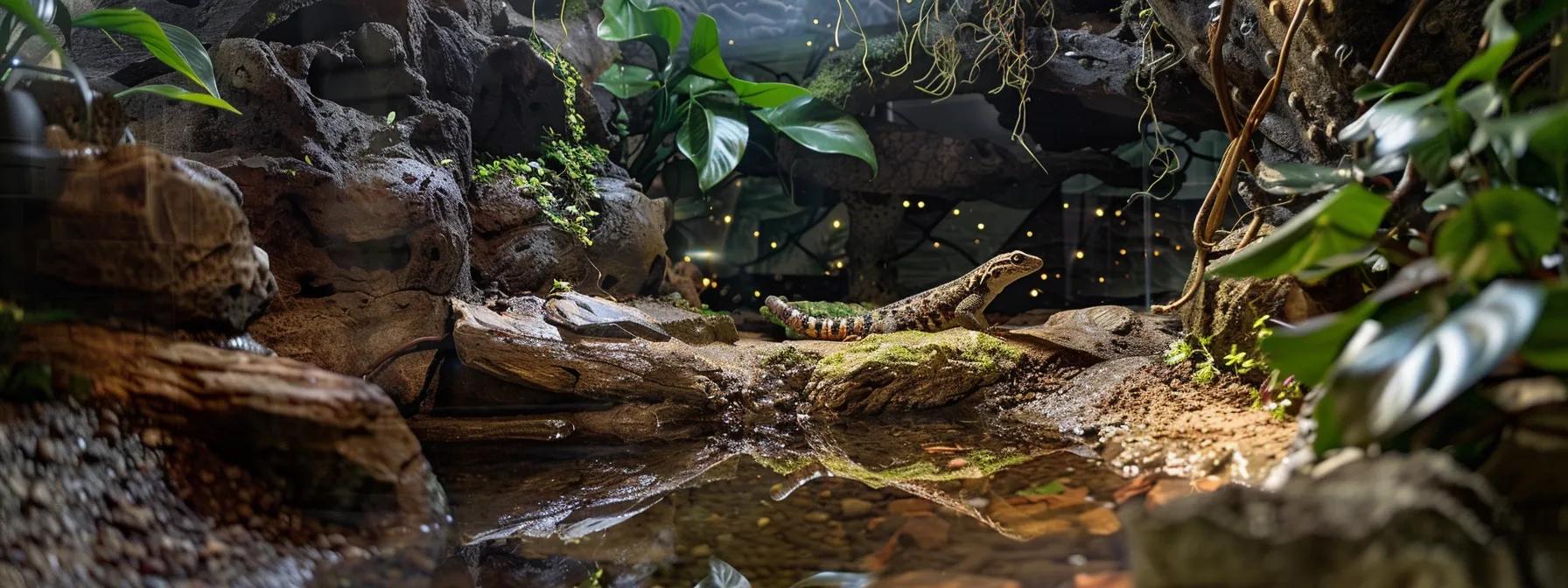
Integrating Water Features Like Waterfalls or Misters
Water features, such as miniature waterfalls or misting systems, can regulate humidity and enhance the sensory appeal of your vivarium. These features should be carefully planned to avoid excess moisture that may lead to mold. Use waterproof, non-toxic materials and secure drainage solutions, and maintain them regularly to adjust water pH or mineral content. The soothing sound of cascading water adds a calming, naturalistic ambiance.
Utilizing Multi-Level Platforms for Vertical Space
Multi-level platforms maximize vertical space and create distinct temperature zones within the enclosure. Using PVC pipes, non-toxic resin, or reinforced foam, build interconnected pathways, ramps, and ledges that encourage climbing and exercise. These dynamic platforms allow your lizard to choose the most comfortable basking spot while adding considerable visual depth to the vivarium.
Creating Custom Hideaways With Multiple Entrances
Advanced decor projects can include custom hideaways with multiple entry points, giving your lizard greater control over its space. Construct these shelters from materials like polymer clay, resin, or natural rock to resemble burrows or rock cavities. Ensure the structure allows free movement and is robust through non-toxic sealing. Camouflage enhancements like moss or small plants improve both appearance and functionality.
Implementing Backgrounds That Offer Climbing Opportunities
Custom backgrounds can serve as both stunning visual backdrops and integral climbing structures. Fabricate these from layered foam, plaster, or even 3D-printed materials designed to mimic natural rock with crevices and ledges. Securely mount these backgrounds so that they blend seamlessly with other decor elements while helping to guide debris to easier-to-clean areas, thus maintaining temperature gradients and a tidy environment.
Combining Different Lizard Habitat Decor Ideas for a Complex Environment
For the ultimate advanced setup, combine elements from desert, rainforest, rocky outcrop, and futuristic themes to create a multi-zonal micro-ecosystem. Design transitional areas with gentle slopes and gradual substrate changes that allow smooth movement across the enclosure. This integrated approach creates distinct zones for basking, hiding, and exploration while ensuring overall harmony in temperature, humidity, and visual appeal.
Table: Comparison of Lizard Habitat Decor Elements
Below is a table summarizing key decor elements, their functions, and benefits for a healthy lizard habitat:
| Decor Element | Primary Function | Benefits | Recommended Materials/Approach |
|---|---|---|---|
| Substrate | Mimics natural ground conditions | Promotes natural burrowing and moisture regulation | Coconut coir, reptile-safe sand, crushed granite |
| Natural Branches | Provides climbing support and perches | Encourages exercise and reduces stress | Real driftwood, untreated wood, resin replicas |
| Secure Hiding Spots | Offers refuge and thermal regulation | Reduces stress and promotes natural hiding behavior | Custom caves, rock formations, commercial hides |
| Live/Artificial Plants | Enhances aesthetics and microclimate | Supports humidity regulation and hides waste | Reptile-safe live plants, high-quality artificial plants |
| Water and Food Dishes | Essential for hydration and nutrition | Prevents contamination and encourages proper feeding | Ceramic or heavy-duty glass dishes |
| Custom Backgrounds | Adds visual depth and climbing opportunities | Immerses environment in a naturalistic theme | Foam, plaster, resin with non-toxic sealants |
| DIY Branches & Platforms | Tailored climbing structures | Stimulates natural exploration and movement | Non-toxic wood, PVC, reinforced foam |
| Edible Landscapes | Integrates nutrition with decor | Encourages foraging behavior and sustains microflora | Safe edible plants, organic substrate blends |
| Water Features | Regulates humidity and adds aesthetic value | Enhances sensory stimulation with natural sounds | Miniature waterfalls, misters, LED integration |
| Multi-Level Platforms | Maximizes vertical space and zones | Provides varied basking and hiding spots | PVC pipes, non-toxic resin, reinforced plastic |
This table illustrates how each decor component contributes to your lizard’s health and natural behavior, forming a dynamic ecosystem that balances functionality with artistic expression.
Frequently Asked Questions
Q: What are the benefits of using natural substrates in a lizard habitat? A: Natural substrates like coconut coir and reptile-safe sand help regulate humidity and encourage natural digging behavior. They create conditions similar to a lizard’s native environment, reducing stress while promoting exploration and proper thermoregulation. In addition, proper substrate maintenance reduces bacterial growth and improves overall hygiene.
Q: How can I ensure that my DIY decor items are safe for my lizard? A: Always use non-toxic, reptile-safe materials such as untreated wood and natural stone when creating DIY decor. Test any homemade items in a small area of the enclosure before full installation to ensure your pet’s safety. Look for materials specifically labeled for reptile use to avoid adverse reactions.
Q: How often should I clean and replace decor in my lizard habitat? A: Regular cleaning is essential. Water and food dishes may need daily or alternate-day washing, while substrates and background elements might require replacement every few months. Develop a maintenance routine based on enclosure size and inhabitant numbers, and inspect decor regularly to replace any degrading items promptly.
Q: Can I combine different habitat themes in one enclosure? A: Yes, many advanced keepers integrate multiple themes—such as rocky outcrops, desert, and rainforest elements—to create a complex, multi-dimensional habitat. Transitional zones are key to maintaining appropriate temperature and humidity throughout the enclosure while ensuring each themed zone supports natural behaviors.
Q: What lighting is recommended to complement habitat decor in a lizard enclosure? A: UVB lighting is critical for vitamin D synthesis and calcium metabolism in lizards. Full-spectrum lighting that mimics natural sunlight enhances the decor’s visual appeal while ensuring even heat distribution. Arrange lighting to highlight key features and support the lizard’s behavioral patterns, following reptile care guidelines.
Q: How do water features benefit a lizard habitat? A: Water features, like small waterfalls or misting systems, help regulate enclosure humidity and create soothing background sounds. They support beneficial microorganisms and enrich the microclimate, especially for species that thrive in moist conditions, without compromising overall stability when properly maintained.
Q: What are some common mistakes to avoid in lizard habitat decor design? A: Avoid using toxic materials, neglecting decor stability, and overcrowding the enclosure. Designs should allow for natural movement and thermoregulation while being easy to clean. Consider the size and scale of decor relative to the lizard to prevent inhibiting natural behaviors.
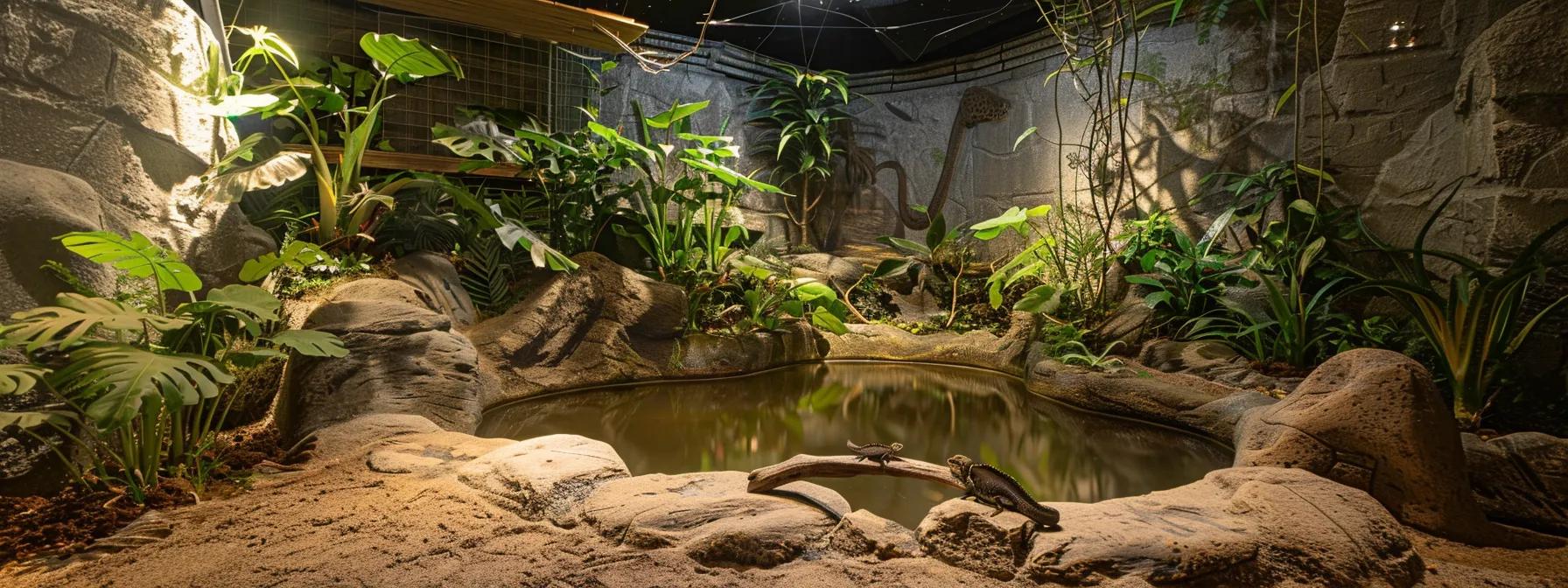
Final Thoughts
Combining functionality with aesthetic appeal creates an enriching environment for your lizard. From choosing non-toxic substrates and constructing multi-level platforms to integrating themed decor and DIY projects, every element contributes to natural behaviors and overall health. By following these guidelines and maintaining regular upkeep, you can transform a standard enclosure into a dynamic, customizable ecosystem that evolves with your pet’s needs.






